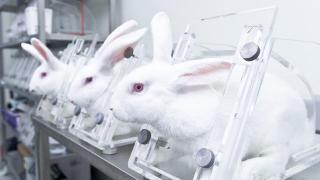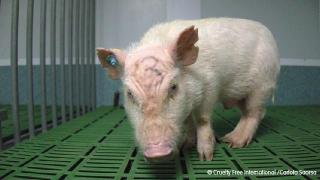Millions of animals are used and killed in scientific procedures every year.
Globally.
- We estimate that at least 192.1 million animals were used for scientific purposes worldwide in 2015. This is the world’s most reliable figure to date.
- This includes nearly 80 million experiments on animals as well as millions of other animals who are killed for their tissues, used to breed genetically modified animal strains and bred but not used.
- We estimate that the top 10 animal testing countries in the world are China (20.5 million) Japan (15.0 million), the United States (15.6 million), Canada (3.6 million), Australia (3.2 million), South Korea (3.1 million), the United Kingdom (2.6 million), Brazil (2.2 million), Germany (2.0 million) and France (1.9 million), in that order.
- In 2015, an estimated 207,724 tests using dogs and 158,780 tests using monkeys were conducted.
- The top 10 users of dogs were: China, the United States, Canada, South Korea, Japan, Australia, Brazil, the United Kingdom, Germany and India.
- The top 10 users of monkeys were: the United States, China, Japan, Brazil, Canada, the United Kingdom, France, Germany, India and South Korea.
Europe
- The latest report from the European Commission shows that 8.8 million experiments were conducted on animals across the EU and Norway in 2020.
- For the first time, the 2020 statistics do not include the UK since it left the EU at the beginning of 2020. Since the UK was the biggest user of animals in the EU, this has had a big impact on numbers.
- The total number of uses decreased by 7% in 2020 compared to the previous year (excluding the UK from 2019 to make the comparison fair).
- Despite increased public demand for a reduction in animal research, there has been little change (approximately 1% year on year) in the 20 years prior to 2020. There was a more significant drop in 2020 but this could be accounted for by laboratory shutdowns as a result of COVID-19.
- According to the EU reports, the Germany conducted the highest number of animal uses in Europe in 2020 (1.9 million). France was the second highest user completing 1.6 million uses in 2020, while Norway was third with 1.4 million uses that year.
- There were 14,096 uses of dogs in 2020 with France (4,079 uses), Germany (2,560 uses) and Belgium (1,519) being the top three users.
- There was a total of 7,316 uses of monkeys across the EU in 2020 with France (3,996 uses), Germany (2,031 uses) and the Italy (504 uses) being the top three users.
- Out of the total number of animal uses in the EU in 2020, 38% were for basic research purposes while only 16% were required by regulators.
- Experiments are still being conducted for regulatory purposes in the EU where there are valid non-animal methods available. In 2020, there were 4,070 skin irritation tests, 491 eye irritation tests, 38,024 skin sensitisation tests, 24,139 pyrogenicity tests and 273,955 batch potency tests on mice to meet the requirements of human medicines legislation (a large proportion of which were likely to be tests for botox products). See more.
UK
- According to the latest Government figures, a total of of 2.76 million (2,761,204) procedures on animals were completed in Great Britain in 2022.
- Of these, 1.25 million (45%) related to the creation or breeding of genetically altered animals who were not used in further experiments.
- The remaining 1.51 million (55%) were actual experiments on animals, which included 457,169 experiments (31%) that even the researchers considered had caused moderate or severe suffering to the animals involved.
- There were 20 severe experiments on dogs, up from zero in 2021.
- Out of the total number of procedures conducted in GB in 2022, only 10% were required by law – the rest were conducted voluntarily.
- A total of 4,122 experiments were conducted on dogs in 2022, including 4,014 experiments on beagles and 108 experiments on other breeds.
- A total of 2,197 experiments were conducted on monkeys in 2022, including 72 experiments on marmosets and tamarins, 2,024 experiments on cynomolgus macaques and 101 experiments on rhesus macaques.
- In 2022, 91% of the monkeys used for the first time in experiments were imported from Africa or Asia.
- There was a significant increase in Lethal Dose 50 (LD50) and Lethal Concentration 50 (LC50) tests from 11,758 tests in 2021 to 12,651 in 2022 (up 8%). These cruel and outdated tests are designed to find the dose or concentration of a substance that kills half of the test animals.
- 2022 saw 248 skin sensitisation and 3,198 batch potency tests on mice (a large proportion of which were likely to be tests for botox products). While these are significant decreases compared to the previous year – particularly for batch potency testing – these are areas in which animals should not be used at all due to the availability of validated replacements. See more.
- We celebrate that, for the first time, zero skin irritation tests on animals were conducted in GB in 2022. Last year we celebrated that, for the first time, zero eye irritation tests on animals were conducted on animals in 2021. Sadly, 2022 saw three eye irritation tests on rabbits, demonstrating that this use has not ended completely.
INFORMATION ABOUT ANIMAL EXPERIMENTS CAN BE EXTREMELY COMPLICATED AND VIEWS OFTEN DIFFER. WHAT APPEARS ON THIS WEBSITE REPRESENTS CRUELTY FREE INTERNATIONAL EXPERT OPINION, BASED ON A THOROUGH ASSESSMENT OF THE EVIDENCE.
FIND OUT MORE ABOUT ANIMAL TESTING
Our History
subtitle: Established in 1898, Cruelty Free International is firmly rooted in the early social justice movement and has a long and inspiring history.
Alternatives to animal testing
subtitle: Alternatives to animal tests are often cheaper, quicker and more effective.
What is animal testing?
subtitle: Animals used in laboratories are deliberately harmed, not for their own good, and are usually killed at the end of the experiment.
Arguments against animal testing
subtitle: Animal experiments are cruel, unreliable, and even dangerous.
Types of animal testing
subtitle: Animal testing is carried out in a wide range of areas, including biological research, and testing medicines and chemicals.






